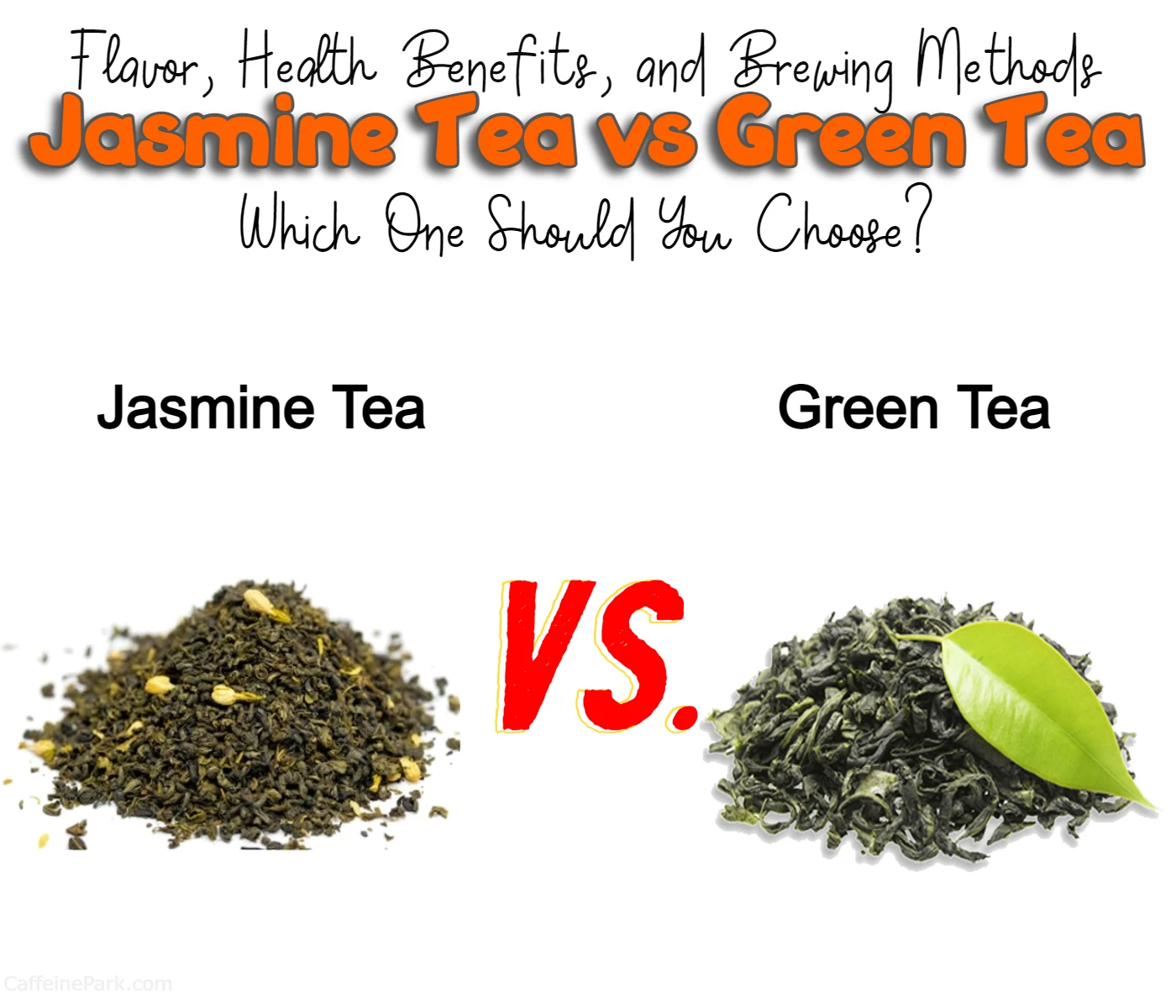Jasmine Tea vs Green Tea

Are you a tea lover looking to expand your palate and try new flavors? Look no further than green tea and jasmine tea! While both types of tea come from the Camellia sinensis plant, they have distinct differences in taste, aroma, and health benefits.
Green tea is known for its fresh, grassy taste and bright green color. It’s a rich source of antioxidants and has been linked to improved brain function, heart health, and weight loss. On the other hand, jasmine tea offers a sweet and floral taste and a calming effect on the body. The scent of jasmine has been shown to reduce stress and anxiety and improve digestion.
But which type of tea should you choose? That ultimately comes down to personal preference and your specific health goals. In this blog, we’ll explore the differences between green tea and jasmine tea in more detail, including their flavor profiles, health benefits, and brewing methods. So grab a cup of tea and read on to learn more about these two delicious and nutritious beverages!
Here is a quick chart comparing the differences between green tea and jasmine tea:
| Factor | Green Tea | Jasmine Tea |
|---|---|---|
| Flavor Profile | Fresh, grassy, slightly bitter | Sweet, floral, calming |
| Health Benefits | Rich source of antioxidants | Reduces stress, improves digestion |
| Brewing Method | Steep for 2-3 minutes at 175°F | Steep for 2-3 minutes at 175°F |
| Caffeine Content | Moderate (20-50 mg per cup) | Moderate (25mg per 8 oz cup) |
| Price | Varies depending on the quality | Varies depending on quality and origin |
Keep in mind that the flavor and health benefits of each type of tea can vary depending on the specific variety and quality of the tea. It’s always a good idea to choose high-quality teas and follow the recommended brewing instructions to get the most out of your tea experience.
Difference between Green and Jasmine tea
Green tea and jasmine tea are both popular and beloved types of tea. They offer a unique taste and aroma that sets them apart from other types of tea. While they share some similarities, they also have distinct differences that make each of them unique. In this article, we’ll explore the difference between green tea and jasmine tea.
What is green tea?
Green tea is made from the leaves of the Camellia sinensis plant, the same plant that is used to make black tea, oolong tea, and white tea. The leaves are picked, steamed, or pan-fired, and then dried. This process helps to preserve the natural green color of the leaves and maintains the health benefits of the tea.
Green tea is known for its light and delicate flavor, as well as its numerous health benefits. It contains high levels of antioxidants, which can help to reduce inflammation and protect against disease. It is also a rich source of catechins, which are compounds that have been shown to improve brain function and reduce the risk of cancer.
What is jasmine tea?
Jasmine tea is a type of scented tea that is made by blending green tea with jasmine flowers. The jasmine flowers are picked early in the morning when the flowers are still closed and then stored in a cool place until nightfall. When the flowers open in the evening, they are mixed with green tea leaves. The tea leaves absorb the fragrance of the jasmine flowers, giving the tea a sweet and floral aroma.
Jasmine tea is a popular type of tea in China, where it has been enjoyed for centuries. It is known for its delicate and sweet flavor, as well as its calming effect on the body. In traditional Chinese medicine, jasmine tea is often used to help reduce stress and anxiety.
The difference in taste
One of the most significant differences between green tea and jasmine tea is its taste. Green tea has a light and refreshing taste that is slightly bitter and grassy. It is often described as having a “vegetal” flavor, with a hint of sweetness.
Jasmine tea, on the other hand, has a much sweeter and more floral taste. The jasmine flowers give the tea a distinct aroma that is often compared to the scent of fresh flowers. The taste of jasmine tea is delicate and smooth, with a subtle sweetness that lingers on the palate.
The difference in caffeine content
Green tea and jasmine tea both contain caffeine, but the amount can vary depending on the specific variety and quality of the tea. On average, a cup of green tea contains between 20-50 mg of caffeine, while a cup of jasmine tea typically contains around 25mg of caffeine.
It’s worth noting that the caffeine content in tea can be affected by several factors, such as brewing time, water temperature, and the amount of tea used. If you’re looking to reduce your caffeine intake, you can try brewing your tea for a shorter amount of time or using a lower water temperature.
While caffeine is known for its stimulating effects, it can also have some potential health benefits. Studies have shown that moderate caffeine intake may help to improve brain function, boost metabolism, and reduce the risk of certain diseases. However, it’s important to keep in mind that too much caffeine can cause jitters, anxiety, and sleep disturbances, so it’s best to consume it in moderation.
The difference in aroma
Another difference between green tea and jasmine tea is its aroma. Green tea has a mild and slightly vegetal aroma, with a hint of grassiness. It has a clean and refreshing scent that is often described as “grassy” or “herbaceous.”
Jasmine tea, on the other hand, has a much stronger and more floral aroma. The jasmine flowers give the tea a sweet and fragrant scent that is often compared to the scent of fresh flowers. The aroma of jasmine tea is delicate and calming, making it a popular choice for relaxation and stress relief.
The difference in color
Green tea has a pale green color that is clear and bright. The color of the tea can vary depending on the quality of the leaves and the brewing time, but it is generally a light and refreshing shade of green.
Jasmine tea, on the other hand, has a pale yellow color that is slightly cloudy. This is because of the presence of the jasmine flowers, which give the tea a cloudy appearance. The color of jasmine tea is delicate and soft, reflecting the delicate flavor and aroma of the tea.
The difference in health benefits
Both green tea and jasmine tea offers numerous health benefits, but they have different strengths. Green tea is known for its high levels of antioxidants, which can help to reduce inflammation and protect against disease. It is
also a rich source of catechins, which have been shown to improve brain function and reduce the risk of cancer. Drinking green tea has also been linked to improved heart health, weight loss, and a reduced risk of type 2 diabetes.
Jasmine tea, on the other hand, is known for its calming effect on the body. The scent of jasmine has been shown to reduce stress and anxiety, making it a popular choice for relaxation. It has also been linked to improved digestion and a reduced risk of certain types of cancer.
While both green tea and jasmine tea offer health benefits, it’s important to note that the specific health benefits may vary depending on the quality of the tea and the brewing method. It’s always best to choose high-quality teas and follow the brewing instructions to get the most health benefits out of your tea.
How to brew green tea and jasmine tea
Brewing green tea and jasmine tea is relatively simple, but there are a few key differences to keep in mind. Here’s how to brew each type of tea:
How to brew green tea:
- Start with high-quality green tea leaves. Look for leaves that are bright green and have a fresh scent.
- Heat water to the appropriate temperature. Green tea should be brewed with water that is around 175°F (80°C).
- Add the green tea leaves to a teapot or infuser. Use about 1 teaspoon of leaves per cup of water.
- Pour the hot water over the tea leaves and let steep for 2-3 minutes.
- Strain the tea leaves and serve.
How to brew jasmine tea:
- Start with high-quality jasmine green tea leaves. Look for leaves that are bright green and have a fresh scent.
- Heat water to the appropriate temperature. Jasmine tea should be brewed with water that is around 175°F (80°C).
- Add the jasmine green tea leaves to a teapot or infuser. Use about 1 teaspoon of leaves per cup of water.
- Add a few jasmine flowers to the teapot or infuser.
- Pour the hot water over the tea leaves and let steep for 2-3 minutes.
- Strain the tea leaves and flowers and serve.
Final thoughts
In conclusion, green tea and jasmine tea are both unique and flavorful types of tea. While they share some similarities, they also have distinct differences in taste, aroma, color, and health benefits. Whether you prefer the light and refreshing taste of green tea or the sweet and floral taste of jasmine tea, both are great options for anyone looking to enjoy a delicious and healthy cup of tea. Just remember to choose high-quality teas and follow the brewing instructions to get the most out of your tea experience.
FAQs
Yes, both green tea and jasmine tea are made from the leaves of the Camellia sinensis plant. However, jasmine tea is typically green tea that has been scented with jasmine flowers.
Green tea is a rich source of antioxidants, which can help to reduce inflammation and protect against cell damage. It has also been linked to improved brain function, heart health, weight loss, and a reduced risk of type 2 diabetes.
Jasmine tea has been shown to have a calming effect on the body and can help to reduce stress and anxiety. It has also been linked to improved digestion and a reduced risk of certain types of cancer.
To brew green tea, start with high-quality green tea leaves and heat water to around 175°F (80°C). Add the leaves to a teapot or infuser, use about 1 teaspoon of leaves per cup of water, and let steep for 2-3 minutes. To brew jasmine tea, follow the same instructions for green tea, but add a few jasmine flowers to the teapot or infuser along with the leaves.
The answer to this question depends on your personal preferences and health goals. Both green tea and jasmine tea offer unique flavor profiles and health benefits, so it’s a good idea to try both and see which one you prefer. Additionally, it’s important to choose high-quality teas and follow the brewing instructions to get the most health benefits out of your tea.
Read More:
Contents





